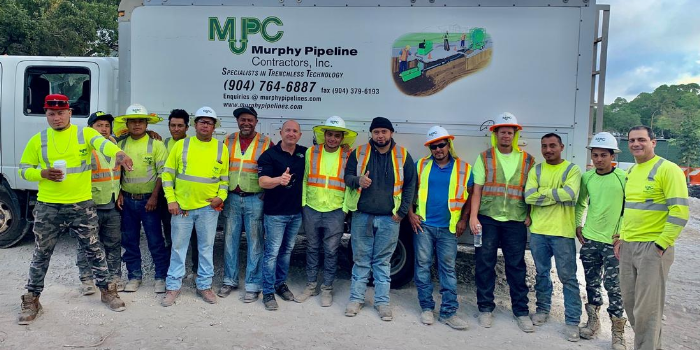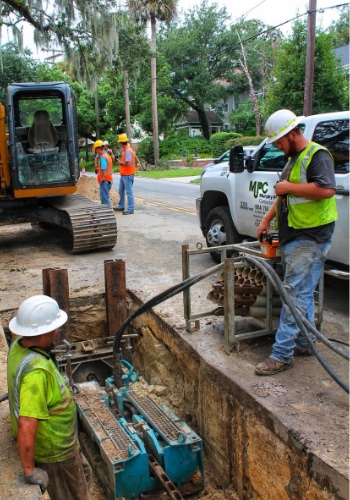The underground infrastructure in North America is in decline. A surge in economic growth in the 1950s boosted the construction of underground infrastructure. The pipelines are aging beyond standard repair, having lost their structural integrity.
Water and sewer pipe breaks create flooding, property damage, increased municipal maintenance budgets, traffic and business disruptions and more.
There are two options available for undertaking a repair and rehabilitation project, says Todd Grafenauer, vice president and educational director for Murphy Pipeline Contractors.
- One is open cut, also known as open trenching.
- The other is trenchless technology, also referred to as no-dig technology.
Open cut requires opening up the surface of the ground for the installation, repair or replacement of underground utilities, he explains. Once the work is completed, the excavation is backfilled.
Trenchless technology is a form of underground construction that uses techniques and equipment to install, repair or replace underground infrastructure to avoid, or at least minimize, excavation that digs up ground, trees and sidewalks and disrupts traffic, businesses and people, says Grafenauer.
Headquartered in Jacksonville, FL, Murphy Pipeline Contractors is a leader in trenchless technology. It was founded in 2000 to bring the trenchless technologies of Europe to the United States. While the focus is on pipe bursting, sliplining and compression fit pipe lining, the company also provides general contracting services such as constructing water and sewer mains.
Pipe bursting is a process in which the existing deteriorating pipe is fractured, sending the pieces into the ground around it, explains Grafenauer. At the same time, the replacement pipe is pulled into place.
Sliplining involves inserting into an existing pipe a new pipe with a smaller outside dimension, he says. With compression fit pipe lining, a high-density polyethylene (HDPE) pipe with an outside diameter larger in size than the inside of the host pipe to be replaced is pulled into the host pipe. The HDPE pipe expands for a tight, compression fit, which maximizes the final internal diameter for greater flow.
 A History of Trenchless Technology
A History of Trenchless Technology
Trenchless technology originated in the United Kingdom in the 1970s and “was born out of necessity,” says Grafenauer. At the time, British Gas controlled all the gas infrastructure throughout the UK. The company had millions of miles of metal gas mains that had come to the end of their useful life and had to be replaced.
“The only method at the time to replace the pipe was open cut,” he points out. “Replacing the gas mains through the suburbs of London and downtown areas, and just the sheer amount pipe required, was an impossible task. British Gas engineers went to work developing technologies that would be fast, less expensive and have a far less impact on the community during construction.
“That is how pipe bursting and compression fit came about. Once these technologies were perfected, they transitioned into the water and sewer industry.”
Andy Mayer, president of Murphy Pipeline Contractors, is a native of England. He worked at British Gas and helped with the development of the technologies. He moved to the U.S. in 1999 and began introducing the technologies to North America.
Trenchless Technology Adoption
Grafenauer notes that in 2014, about 10 percent of the water and sewer market was using trenchless technology; 90 percent was open cut. By 2018, it was 25 percent and 75 percent
According to trends and data, he expects that in about 10 years, 75 percent of all water and sewer projects will be using trenchless technology.
“Trenchless technology saves costs and reduces friction on both the engineering and construction sides,” he says. “There is a minimum impact to busy urban areas, traffic flow, businesses, homeowners and pedestrians. Plus, it reduces costs for cities, all of which are trying to do more with less when it comes to repairing and replacing their underground infrastructure.”
Finding and Retaining Skilled Labor
Like many companies in the construction industry, Murphy Pipeline Contractors struggles to attract, hire and retain workers.
“There are not enough skilled people in this country to get to all the work done that needs to be done,” says Grafenauer. “It has been a real challenge for us to find skilled people.”
The company uses a variety of recruitment methods to attract workers. These include crew referrals, advertising, recruitment agencies, job boards, online and social media.
Murphy Pipeline Contractors recently built a new facility in Jacksonville, FL, and consideration is being given to instituting a training school. The idea, he says, is to train those outside the industry, as well as work with schools and technical colleges to put together a technology training program to fill the need new for workers in the water and sewer industry.
One of the most effective things the company does to retain workers is to provide opportunities for them to advance. This, notes Grafenauer, has been successful because workers are more engaged at work when they know they can grow, rather than feel stuck in one position.
 Keeping an Eye on Technology
Keeping an Eye on Technology
Because developing technical knowledge and being better able to apply new technologies is becoming a more critical factor for future business success, Murphy Pipeline Contractors keeps a constant eye on evolving technologies for the water and sewer industry. Additionally, it has its own R&D program.
“Technology is continuously improving and it is paramount to remain on top of it to maintain and keep an edge,” Grafenauer says.
One of the ways the company does this is through its strategic relationships around the world, he says. These partnerships build momentum for advancing technology.
“One of Andy’s top-of-mind priorities is continuously pushing boundaries,” notes Grafenauer. “We have a large R&D program within the company. Because continuous R&D is fundamental for growth, the company is always reinventing, developing, innovating and improving technologies to better the industry.”
Strong Core Values
Grafenauer says there are six cores values that serve as the foundation that Murphy Pipeline Contractors company is built on:
1. Fearlessness – Do not fear failure. Understand there are always risks and there will be failures. Learn from them. Companies either grow or shrink. There cannot be complacency.
2. Provide Solutions – The old way of bidding on a water/sewer project – to be the lowest bid and then make a profit off change orders – is broken. Work as a team with clients to tackle challenges and provide solutions to those challenges.
3. Employees are Family – Technology will commoditize everything except for the people.
4. Team – Work as a team on water/sewer projects. Take away the stigma between contractor, city, engineer. One singular thought pattern on the movement of a project results in a successful outcome.
5. Educate – As Nelson Mandela said: “Education is the most powerful weapon which we can use to change the world.”
6. Not Being Litigious – There are always better ways to work through disputes and challenges.
Building a Brand Through Social Media
Murphy Pipeline Contractors places an emphasis on educating the industry, civil engineers, government entities, etc., about trenchless technology.
“We are big users of multiple platforms, including social media and have a large online presence to help with our educational efforts,” Grafenauer says. “We do live events on Instagram, LinkedIn and Facebook. In today’s world you no longer need to be a commercial, as you have the ability to be the show.”
He points out that these efforts are “not intended to sell anything. They are designed to further educate and build our brand. From conception, our brand has always been to reduce community impact during construction. Building our brand helps set us apart from the industry.”
Formerly known as ICUEE, The Utility Expo is the largest event for utility professionals and construction contractors seeking comprehensive insights into the latest industry technologies, innovations and trends. The biennial trade show, known for equipment test drives and interactive product demonstrations, takes place in Louisville, KY. The next edition will be September 28-30, 2021. For the latest information and news, sign up for show alerts.
Join thousands of industry peers who receive utility construction industry news and trends each week. Subscribe to The Utility Expo Newsletter.












